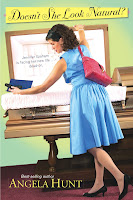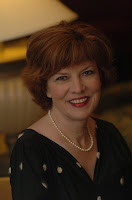A great color on anyone
 I love the cover on my friend Angie Hunt’s newest novel. Red’s been my favorite color since grade school and I’m hard-pressed to find anyone who doesn’t look good in it. Angie’s stopping by the Edge today to talk about She Always Wore Red, the second in her Fairlawn Series.
I love the cover on my friend Angie Hunt’s newest novel. Red’s been my favorite color since grade school and I’m hard-pressed to find anyone who doesn’t look good in it. Angie’s stopping by the Edge today to talk about She Always Wore Red, the second in her Fairlawn Series.
Here’s a little teaser before we head to the interview: Jennifer Graham—mother, student, and embalmer’s apprentice—could use a friend. She finds one in McLane Larson, a newcomer to Mt. Dora. While McLane’s soldier-husband serves overseas, Jen promises to support her new friend, then learns that her tie to this woman goes far deeper than friendship. When a difference of opinion threatens their relationship, Jennifer discovers weaknesses in her own character . . . and a faith far stronger than she had imagined.
Romantic Times gave She Always Wore Red Top Pick status, always a great thing: “Be prepared to shed a few tears in Hunt’s emotionally gripping tale, the second in the Fairlawn series. With themes of family, friendship, and trusting God, the plot is enhanced by realistic and engaging characters. Jennifer’s growth as a character is evident, and the supporting cast enhances the story in a significant way. “ —Melissa Parcels, Romantic Times reviewer.
Edgewise: Now then, Ang. The first book in this series is Doesn’t She Look Natural? Do people have to read the first book in order to understand the second? (And congratulations on the Christy Award nomination for that title!)
Angie: Thank you—I’m honored. And no, people don’t have to read the first book first, though it’s always nice to read the books in order to get a sense of the story and background. But all the books will work as single title reads.
Edge: The Fairlawn series is set in a funeral home. What kind of research did you do to, uh, get up close and personal with embalming fluid?
Ang: Unfortunately, with the advent of all the new privacy laws (HIPPA, anyone?), I was unable to observe an embalming—and believe me, I was ready and willing. So most of my research came from books, photographs, and interviews (and once you announce that you’re working on funeral homes, morticians seem to come out of the woodwork!) It just so happens that one of my Tyndale editors grew up in a funeral home. She has been a great asset—she gave me the idea for the funny flower arrangements and the funeral singers, plus I had written a scene in book three where Jen and Gerald sit down to eat a steak in the prep room. My editor said that didn’t feel right. “Too weird?” I asked. “No,” she said. “There’s always an odor in that room . . . not very appetizing.” Ah. That’s the sort of thing you can’t always get from a book. :-/
I certainly hope the embalming stuff didn’t gross anyone out, and I tried to ease my readers into it just as Jen is herself “eased” into it. Book one, the barest trace; book two, a complete description of an arterial embalming; book three, the cavity embalming. And frankly, that’s as far as I want to take it. Any more would be gross for grossness’s sake.
Edge: Did you and your editors disagree over how much of the body preparation process was acceptable to include?
Ang. Actually, the embalming you “see” is the embalming I put in. 🙂 After 20 years in this business, I think I’ve developed a pretty good instinct for knowing how much is too much. And you can be descriptive in a way that is clinical rather than gross (” She searched for the carotid artery” as opposed to “her stomach clenched as her gloved fingers eased into the warm opening and she tried not to think of fish guts”). So actually, none of my editors ever remarked on the level of detail . . . and none of my readers have complained. Yet. 🙂
Edge: How has working on this series changed your attitude about death?
Ang: I’m utterly at peace about it—not in a hurry to pass on, you understand, but very relaxed about the process and my final destination. Doing research has also convinced me that I want to be buried, not cremated, and that I’d be better off buying my casket online.
Edge: Can you give us a hint about what happens in the third and final Fairlawn book?
Ang: Sure. People die and Jennifer buries most of them. It’s a funeral plot.
Edge: (Ba dum bump) That’s not much of a hint.
Ang: I don’t like to give all the plot twists away! Okay, here’s a blurb from the back cover copy (yes, the book is finished and handed in): In She’s In a Better Place, the third book of the Fairlawn series, Jennifer Graham is now running the Fairlawn Funeral Home. Her work takes on a new dimension when Gerald Huffman, her assistant and mentor, reveals that he has a serious illness. When she learns that he and his daughter haven’t spoken in years, Jen decides to help them reconcile . . . but things don’t go exactly as she planned. Once again, the mortuary is a setting for lessons of laughter, love, and life.
Edge: The setting—a funeral home—is unique, but these books are really about the typical challenges that face women today, right?
Ang: Oh, yes. Jennifer is a single mom juggling school, motherhood, and a career–and I think most modern women can relate to her. I certainly can.
Thanks for dropping by the Edge, today. Angie. You can catch Angie on her own blog, the fascinating “A Life in Pages.”
Have a stellar weekend, everyone.

.jpg)
